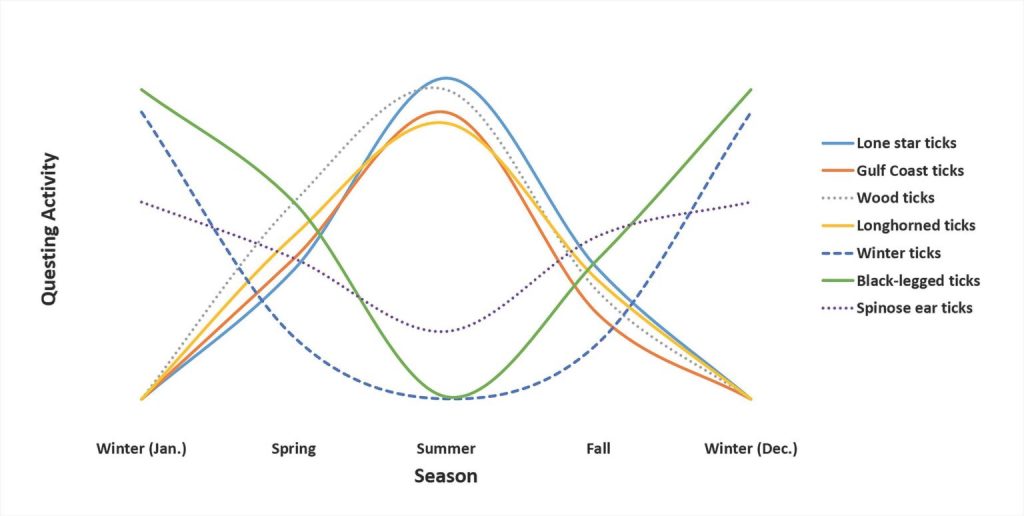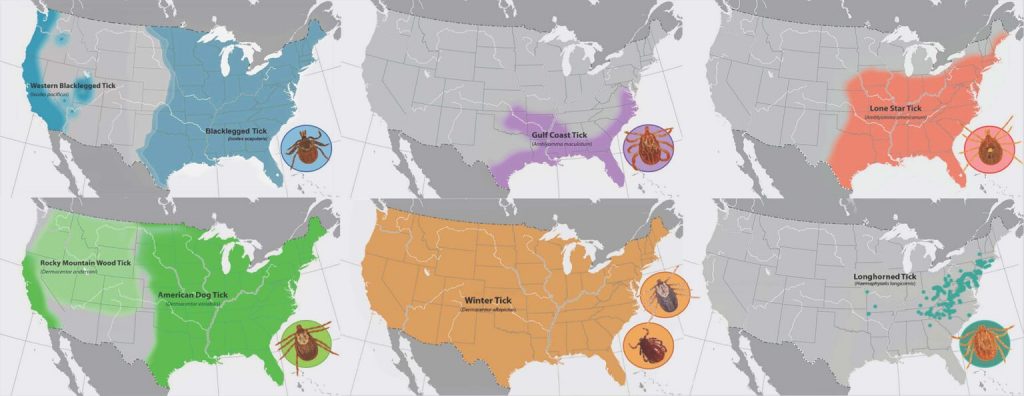May 9, 2023 – Article Credit: US Rider – Read Original Article HERE
These tiny parasites feed on your horse’s blood and can pass along several pathogens as they do. Here’s what you need to know to protect your horse from the growing threat of ticks.
BY KATHRYN DUNCAN, DVM, PHD, AND KELLEE D. SUNDSTROM, MS
Ticks are relentless, blood-feeding ectoparasites that infest almost every type of animal, including horses. With a resume like that you’d think we’d all be on high alert, all the time, to ensure ticks are identified and disposed of before they have the opportunity to attach to our horses. However, equine tick infestations can go undetected, even by conscientious owners, due to the horse’s thick hair coat and the tick’s small size. Couple that with a widespread misconception that ticks only feed in warmer months of the year or in certain habitats, and ticks persist as a particularly icky equine parasite.
But ticks are more than gross. They can cause skin irritation, secondary infections at bite wounds and even anemia. Most concerning, ticks can pass along pathogens, such as those that cause equine piroplasmosis and Lyme disease. As global climate trends have led to increasing tick populations and expanded distributions, these tiny arachnids are becoming an increasingly significant equine health concern. All of which makes it more important than ever to learn which tick species are most likely to bite your horse and the threats they pose when they do.
The Seven Tick Species Of Greatest Concern
Although many species of ticks can infest horses, some are more common than others. Geography, landscape and time of year influence which types of ticks your horse is most likely to encounter. Be aware that even less-common species can cause significant health problems, so it’s important to still be on alert for them. Here’s a rundown of ticks that most commonly cause problems in horses.
1. Black-legged ticks or deer ticks (Ixodes scapularis and Ixodes pacificus). These small ticks are dark brown to black in color. Unlike many other North American ticks, black-legged ticks search for hosts (a behavior described as “questing” by entomologists) during the cooler months of the year. They tend to be found on woody understory—the lower level of vegetation—protruding from dense leaf litter in forested regions. They also rely on white-tailed deer to maintain their populations but will readily feed on other medium or large mammals. Ixodes scapularis is the black-legged tick found in abundance in eastern North America while Ixodes pacificus is encountered west of the Rocky Mountains; both species readily infest horses.
2. Lone star ticks (Amblyomma americanum). This aggressive tick is found most often in wooded areas with ample leaf litter that preserves moisture. Adults may track potential horses using shadows or carbon dioxide from exhalations. These ticks are reddish-brown, and a female will have a white dot on its back while a male will have white markings along the edge of its body. All three stages (larvae, nymphs, and adults) may be found on horses, although identifying the tiny, immature larvae and nymphs requires close, careful examination. Historically, the distribution of this tick was concentrated in the southcentral and southeastern United States, but over the last decade, populations have extended their range to eastern and midwestern regions.
3. Gulf Coast ticks (Amblyomma maculatum). This ornately patterned and rather large tick thrives in open areas, coastal wetlands and grasslands. It feeds on a variety of hosts regardless of life stage and may be seen questing during the heat of the day when other ticks are taking refuge from the hot sun under leaf litter. As the name implies, this tick is found in regions neighboring the Gulf Coast, but populations have expanded and it can now be found as far north as Kansas in the Midwest and up the East Coast as far as Connecticut. This tick is a notoriously deep feeder, leading to significant skin trauma at the site of attachment. For example, Gulf Coast ticks can induce a condition called “gotch ear” in horses, mules, cattle and goats, where numerous ticks are attached to the inner and outer surface of the ear pinnae, resulting in severe inflammation and droopy ears.
4. Wood ticks (Dermacentor variabilis and Dermacentor andersoni). Virtually identical in shape and markings to one another, wood ticks are brown with a white lacy pattern along the back. These ticks prefer grassy areas near forest boundaries and are often seen along edges of trails. Adults feed on medium to large mammals; a recent study found Dermacentor variabilis to be the second most common tick infesting horses in the summer. Considered together, wood ticks are found in every region of the United States, though Dermacentor variabilis (American dog tick) is more prevalent in the Northeast, South, Midwest and along the Pacific Coast, while Dermacentor andersoni is encountered solely in the Rocky Mountain states.
5. Winter ticks (Dermacentor albipictus). Uniquely, this tick lives on a single host through all life stages (larva, nymph, adult). Larvae quest for a host in large groups in the cooler months of the year, and after feeding molt to the next life stage on the same host. Because they attach in large numbers and stay on the same host for the entire season, heavy infestations can cause anemia. Winter ticks survive in a variety of environments, including open and closed canopy forests. They primarily feed on wild ruminants such as moose, elk and deer, but are often found on cattle and horses. This tick is widely distributed across North America. In its southern range, a solid brown variant (no pattern on the back) predominates. In other regions, adult winter ticks have a similar white, ornate pattern as the wood ticks.
6. Asian Longhorned ticks (Haemaphysalis longicornis). Newly introduced to North America, this reddish-brown tick has no markings and is found on a variety of hosts, including horses. Longhorned ticks thrive on long grasses in humid, warm conditions but can survive in a variety of climates. Though the distribution is currently concentrated in the eastern United States, where it was first recognized in 2017, this tick has been found as far west as Arkansas and the range is expected to continue expanding since this tick is adaptable to many climates and hosts. In addition, longhorned ticks are parthenogenic, meaning no males are needed for successful reproduction.

7. Spinose ear ticks (Otobius megnini). Only the immature stages (larva and nymph) of this tick feed on animals, including horses. They usually attach deep in the ear canal. Adults are free-living in the environment and do not feed on blood. Referred to as a soft tick, based on the lack of a hard outer covering, spinose ear ticks are intensely irritating. An infested horse may frantically tilt his head or throw himself to the ground in response to the sensation of ticks feeding in the external ear canal. This tick is most common in the hot, dry environment of the southwestern United States and Mexico.
The Pathogens Ticks Bring
You may be aware of Lyme disease and equine granulocytic anaplasmosis —both currently considered the most common tick-borne diseases affecting horses in the United States—but several other pathogens spread by these tiny parasites are also cause for concern. Here’s an overview of the tick-borne diseases most seen in horses:
• Lyme disease. One of the most well-known tick-borne diseases, Lyme disease is caused by the Borrelia burgdorferi organism, which is transmitted by black-legged ticks. In horses, Lyme disease may cause enlarged lymph nodes, inflammation of the eye, neurologic abnormalities and occasionally stiffness or lameness. Treatment of Lyme disease in horses, which entails the administration of antibiotics, is similar to the protocol for dogs; however, the extent of drug dispersal and effectiveness in horses is not fully understood. Given the ongoing range expansion of the tick vector and bacterial pathogen system in North America, equine Lyme disease is of increasing concern. Vaccination is not available for horses and the true extent of disease after an active infection is unknown, which makes early diagnosis and treatment by a veterinarian even more important.
• Equine granulocytic anaplasmosis. Not to be confused with anaplasmosis in cattle due to Anaplasma marginale, this disease (equine granulocytic anaplasmosis) is caused by the tick-borne agent Anaplasma phagocytophilum, previously known as Ehrlichia equi. Black-legged ticks are the main vector for this pathogen. The disease is characterized by loss of appetite, lethargy, hemorrhage or lameness. In some horses the condition is self-limiting and does not require treatment, while others improve following administration of antibiotic therapy.
• Equine piroplasmosis. Although not known to be endemic in the United States, equine piroplasmosis (EP) presents a serious concern and regulatory precautions are in place to limit its introduction and spread. The disease is caused by protozoan Theileria equi and Babesia caballi, which circulate in the bloodstream. Dermacentor species, including wood ticks, winter ticks, and the infrequently encountered tropical horse ticks (Dermacentor nitens), can transmit these pathogens as they feed. Although less commonly seen in the United States, cayenne ticks (Amblyomma cajennense complex) were linked experimentally to a 2009 outbreak of EP caused by Theileria equi. Occasional cases of EP in the United States occur when horses are exposed to the pathogen through shared blood-contaminated equipment.
Mild forms of EP cause weakness and lack of appetite, while more severe signs include fever, anemia, weight loss, jaundiced mucous membranes, swelling of the limbs and abdomen and labored breathing. Clinical signs are usually related to destruction of red blood cells and low platelets. Treatment involves quarantine and anti-protozoal medication, which can take months to years to produce negative antibody tests. Even though most horses recover, some EP cases prove fatal. Regional outbreaks can lead veterinary health authorities to limit horse movement, resulting in industry disruptions. Unfortunately, infected horses are carriers of the pathogen for life. Therefore, when a case is suspected, state and federal veterinarians are notified to perform confirmatory diagnostics and manage the treatment protocol.
• Novel equine tick-borne infections. In addition to the known disease-causing agents transmitted by ticks, there are likely novel tick-borne agents that have yet to be characterized or thoroughly described. For instance, preliminary research has documented the presence of antibodies to the bacteria Ehrlichia spp. in as many as 30 percent of horses in the central United States, and more commonly in those horses heavily infested with ticks. However, the potential health implications of these infections, if any, and the specific bacteria responsible have yet to be identified.
• Tick paralysis. Although not caused by an infectious agent, ticks feeding on horses can occasionally lead to progressive weakness, ataxia and recumbency in afflicted horses. Referred to as “tick paralysis,” the condition usually occurs when ticks—most often wood ticks in North America—are simultaneously feeding and regurgitating salivary secretions that contain neurotoxins. These toxins interfere with nerve cell signals and can lead to ascending paralysis, which starts in the legs and moves up toward the body. Luckily, rapid recovery usually occurs after the removal of all feeding ticks.
A Year-Round Threat
Ticks are active year-round, which means horses may be infested at any time if the weather and their habitat allows. As seasonal weather patterns shift, timing of tick activity also changes. And even though immature stages of some species may be found feeding on horses, adults are the stage most often collected. Therefore, the tick threat posed to horses is greatest when adults of each species are most active.
Questing activity varies depending on the region, but generally, lone star ticks, Gulf Coast ticks, wood ticks and longhorned ticks are found on horses in spring and summer. Research has demonstrated that, depending on climate and habitat at a given location, lone star ticks reach peak activity in May, Gulf Coast ticks in July and August, wood ticks in May, June, and July, and current data suggest longhorned ticks peak in July.
In contrast, winter ticks and black-legged ticks (deer ticks) are most active during fall, winter and early spring. Winter ticks are most often collected from horses in Oklahoma in November, December, and January. Activity of black-legged ticks (deer ticks) commonly peaks in October and November, with a second peak in March and April. Spinose ear ticks have been reported from animals year-round but typically are also more active in winter and spring.
Nobody likes thinking about ticks, but they can’t be avoided. Various tick species are active throughout the year, creating a perpetual equine health threat. Products and strategies for combatting tick infestations are relatively limited, but there are measures you can take to protect your horse. By increasing your awareness of the ticks in your area, as well as their seasonality and likely habitats, you can anticipate issues and work to keep them at bay.

News from the horse industry. Sharing today’s information as it happens. The Northwest Horse Source is not responsible for the content of 3rd party submissions.





